Top News
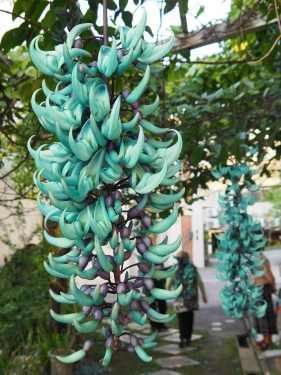
March 10, 2020 Ryukyu Shimpo
At the home of Chieko Yogi in Shuritera, Naha, a jade vine is blooming beautifully.
Her neighbors are enjoying the lovely jade color. According to Yogi, the flowers will probably last until the end of March.
The jade vine is a climbing plant native to Luzon in the Philippines.
It can grow up to 20 meters long. The flowers are five centimeters long and resemble the beak of a parrot.
Yogi received the potted vine from her hula teacher two-and-a-half years ago.
Since planting it in her garden, she has eagerly watched the vine grow.
Yogi loves the color. Even her nail polish is jade. She says that she used to drive a jade car as well.
On March 6, neighbors visited again and enjoyed taking pictures of the jade vine.
Yogi happily says that the vine has become a reason to “call friends and bring people together.”
(English translation by T&CT and Ellen Huntley)
Go To Japanese

March 9, 2020 Ryukyu Shimpo Digital Edition
Okinawa Governor Denny Tamaki announced emergency measures to support business owners suffering from the effects COVID-19 such as the sharp decrease in sales March 9 at an emergency press conference.
Governor Tamaki indicated, “The complex industry that is the tourism business is being affected in many regions, and I can only surmise that these effects are being felt by small and medium-sized business the most,” announcing that they would be raising Japan’s Employment Adjustment Subsidy.
They are also looking into maintaining the international flight routes that have been reducing service one after the other, as well as remote work using lodging facilities in Okinawa.
Okinawa vice-governor Moritake Tomikawa commented on the effects on Okinawa’s tourism industry, the main industry in Okinawa, stressing, “The decline has been major, reaching nearly the levels seen after the 9/11 terror attacks in 2001.”
They are also looking into presenting a 2019 supplemental spending bill to the Okinawa prefectural assembly now in session.
The current voluntary ban on the hosting of events will be lifted once the prefecture is able to scientifically ascertain that the situation has ended.
They also raised the possibility of an advertising campaign to help boost sales for the agriculture, forestry and fishing industries.
Governor Tamaki stressed, “After considering the extraordinary situation that Okinawa is facing, we have decided to immediately use Japan’s emergency measures as well as measures that can be taken by Okinawa Prefecture.”
(English translation by T&CT and Sam Grieb)
Go To Japanese
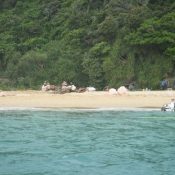
March 9, 2020 Ryukyu Shimpo
Henoko, Nago City—On March 9, the Okinawa Defense Bureau proceeded to fill the coast with sand and dirt as part of the land reclamation project to build a new U.S. military base for the relocation of U.S. Marine Corps Air Station Futenma.
Workers were seen creating a nesting area for the local sea turtles on the beach, near the K9 seawall at Camp Schwab.
According to the captain of a protest ship, the construction site for the new base used to be a nesting spot for sea turtles, but he has never seen the creatures craw onto a beach under construction.
The captain wondered out loud, “Are they consulting experts? It’s hard to believe that this will bring back the sea turtles.”
A citizen aboard the protest ship was clearly angered: “I don’t understand their logic—they destroyed this vulnerable ecosystem and assume it can be artificially recreated using heavy machinery.
It’s a sham.”
–Reporting by the Ryukyu Shimpo’s Henoko news crew.
(English translation by T&CT and Monica Shingaki)
Go To Japanese

March 9, 2020 Ryukyu Shimpo
“Please look at what’s happening in Okinawa.”
That is the message of a letter sent by around 40 students at Okinawa International University to U.N. Secretary-General António Guterres, who will be visiting Japan in August.
The Secretary-General plans to attend the nuclear bomb victim memorial and peace ceremony to be held in Hiroshima, which suffered from the nuclear bomb.
The students proposed that he also visit Okinawa during his trip.
The letter expresses their honest feelings: “the scars of the Battle of Okinawa still remain,” and “our university is side by side with danger.”
The authors of the letter were mainly sophomores in the Department of Society and Regional Culture who took a course on peace philosophy.
In the course, students engaged in active discussion amongst themselves about what peace means in Okinawa, where the Battle of Okinawa took place and where military base issues are ever-present.
Adjunct professor Shoko Oshiro, who oversaw the course, suggested to the students that they convey their thoughts to the U.N. Secretary-General.
Mitsuteru Nakamura, 20, of Chatan, said, “A U.S. military helicopter crashed on Okinawa International University.
I want [the Secretary-General] to know the kind of danger we are living side by side with.” Hiroto Ishikawa, 20, of Naha said, “The scars of battle and military bases remain in Okinawa even now.
Human rights that ought to be protected are not being protected.” Wataru Nakamoto, 20, also of Naha said, “A prefectural referendum was held about the Henoko [base construction], but construction is proceeding as if nothing had happened.
I want [the Secretary-General] to know this preposterous truth about Japan.”
Reading the students’ letter, Professor Oshiro expressed hope, saying, “I could feel their passion.
That’s why I didn’t edit it at all. I think that way their feelings will be conveyed even more honestly.”
(English translation by T&CT and Sandi Aritza)
Go To Japanese
March 6, 2020 Ryukyu Shimpo
The Nansei shoto Industrial Advancement Center (NIAC, Mitsuru Omine, chairman), announced March 5 their estimation for the effect the coronavirus would have on Okinawa’s economy.
The organization predicts that if from February through May, the number of tourists visiting Okinawa decrease by 1.68 million, resulting in a decrease in tourism-related revenue of 110.1 billion yen, would cause the loss of 7,690 jobs this year, raising the overall unemployment rate by 0.42%. However, there is the possibility that a quick resolution to the contagion would reduce the impact.
The NIAC calculated estimations related to the coronavirus collected by the Okinawa Convention & Visitors Bureau (OCVB) March 4, and calculated the effect on Okinawa’s economy based on this data.
Okinawa’s GDP had grown to 4.5362trillion yen as of 2018, however if individual and capital expenditure is curtailed by the reduced tourism, this year’s nominal GDP could go down by 76.7 billion yen, suppressing the real GDP growth by 1.5% for the year.
They also predict a rise in unemployment from businesses adjusting employment, as well as deflation caused by the drop in consumption, resulting in an estimated 0.2% decrease in consumer prices.
Combining both national and regional taxes, this would create a reduction in tax revenue of around 14.7 billion yen.
In recent years, employment in Okinawa had continued to improve as the growth of Okinawa’s economy had created a labor shortage, and in January of this year the number of employed people sat at 737,000 with a total unemployment rate of 3.0%.
Takeshi Kinjo, senior researcher at NIAC who calculated the economic effects of the coronavirus, indicates, “If the situation continued for a lengthy period of time, the severity of the job losses could be major.”
Conversely, if the situation has been resolved by the summertime, a peak season for tourism in Okinawa, a rise in the demand for travel could lead to a rally, especially for companies in the travel industry.
Kinjo says, “There are some positive indicators for the second half of the year for Okinawa’s economy.”
At the OCVB, where the estimations were collected, they forecasted that the loss in revenue from cruise ships cancelling their calls to port as well as the reduction of flights by airlines will total just over 10.1 billion yen in February, and that the losses could total 100 billion yen for the months of March through May.
They are also estimating that there were 180,000 fewer tourists in February, and that there would be 1.5 million fewer tourists from March through May.
(English translation by T&CT and Sam Grieb)
Go To Japanese

February 28, 2020 Ryukyu Shimpo
On February 27, in Shurijo Castle Park, Naha, Okinawa, basic repairs began on the Giant Dragon Pillars that were damaged in the Shuri Castle Fire. The fire destroyed parts of the castle, including the main hall, last October.
According to the Okinawa General Bureau, the pillars will be protected in their current location until Golden Week in May, when the site of the fire will be opened to the public.
After that, the pillars will be moved into the park where repairs will be conducted on cracked sections.
“All of Japan is interested, not just Okinawans,” says Takehiko Suzuki, Director of the Okinawa Commemorative National Government Park Office.
Visitors to the park will be able to see how repairs are going.
The site was opened to the press on the 27th. The dragon pillars which survived the fire are made of fine-grained sandstone from Yonaguni Island.
Each is approximately 3.1 meters tall and weighs 1.5 tons. The pillars stand facing each other in front of the main hall, which burned to the ground.
In addition to surface discoloration, the pillars also exhibit cracks and some breakage due to the fire. General Bureau staff plan to conduct a thorough survey of the damage soon.
(English translation by T&CT and Ellen Huntley)
Go To Japanese
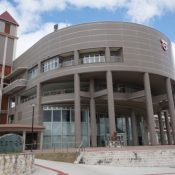
March 2, 2020 Ryukyu Shimpo
By Manato Akira, Wakana Arakaki, and Mikako Shimoji
Waste containing high concentrations of dioxins was found at a returned U.S. military base site in Kamiseido, Chatan Town in Okinawa Prefecture, which had been designated for the construction of a residence.
As of March 1, the town government has decided to purchase this land from the landowner using town funds.
In the budget proposal for FY2020, about 54 million yen is being appropriated toward the purchase of the land.
The central government is showing no sign of providing compensation for this purchase by the town government.
One expert pointed out that: “Due to the lack of laws concerning returned U.S. military base sites, the disadvantage to landowners has long been veiled.
This is an issue that will occur hereafter in Okinawa”.
This land was a portion of Kadena Air Base returned to Okinawa in 1996, and Chatan Town carried out land readjustment on the land.
A portion of the Kamiseido land was supplied, as a substitute plot of land, to a townsperson who had been evicted from another area on which a park was built.
During construction of this residence in 2011 waste was found underground, and afterward, dioxins exceeding legal standards were detected.
From the outset, the landowner who found waste on the land requested that the town take action.
The landowner abandoned construction of the residence, and was forced to rent a place to stay.
Thereafter, since the land could not be used as expected and was taking a physical and mental toll on the landowner, the Chatan Town government decided to purchase the land. The use of the land once purchased has not yet been determined.
A contact person at the Chatan Town government said that this special measure will be taken, given that “It is harmful that the residence did not work out, and we determined that this is very urgent.
We will act in accordance with the intentions of the landowner”.
The contact person emphasized that if waste is similarly found in the soil on another landowner’s plot of land, to the disadvantage of the landowner, “We will request that the Defense Bureau handle the situation”.
In an interview with the Ryukyu Shimpo, an Okinawa Defense Bureau spokesperson responded to an inquiry, saying that “There is no plan to purchase the land”, and explained, “We are currently discussing how to handle the loss covered by the town”.
(English translation by T&CT and Erin Jones)
Go To Japanese
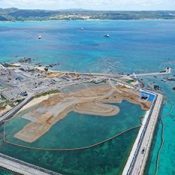
March 3, 2020 Ryukyu Shimpo
The Okinawa Defense Bureau stated on March 2 that the land reclamation work to add a new U.S. military base in Henoko, Nago City, will not be suspended as part of the ongoing efforts to control the spread of the new coronavirus strain, COVID-19.
The bureau said it conferred with its contractors and none had plans to halt the construction.
This was revealed by the bureau while responding to questioning by Okinawa’s elected members of Diet.
Previously, in a press conference held on February 28, Kazuyoshi Akaba, Minister of Land, Infrastructure, Transport and Tourism, had stated that public works projects would be temporarily suspended or delayed in response to the coronavirus threat.
(English translation by T&CT and Monica Shingaki)
Go To Japanese

March 1, 2020 Ryukyu Shimpo
Yoko Oshiro reports
Starting on January 17, Europe’s largest home décor fair, Maison et Objet, was held for five days at the Villepinte Exhibition Center in the suburbs of Paris. The wallpaper collection from Binryu, the original brand of Araya Planning, a Ginowan company that produces goods using bingata textiles, captured the attention of fairgoers.
This was the second time Binryu was exhibited at Maison et Objet. Last time, the company exhibited mainly kitchen items, and exhibited the same items that it sells domestically in Japan, but since the products diverged significantly from the European style in terms of size and other factors, it faced difficulty. Therefore, this time it developed and exhibited new products with an eye toward expanding into Europe. Husband and wife Hideki, 46, and Nahoko, 45, Shimoji, the company’s representatives, saw their development work rewarded, as they received many inquiries at the fair, decided on an agent to sell their goods in France, and also struck up business talks with prospective customers in Italy and Monaco.

Nahoko Shimoji attending to a customer.
Binryu was established in 2006. The couple says that it started when they made a leash and collar for the golden retriever that lived with them at the time. They plan to keep making goods that add fun and joy to people’s lives and that people will want to give as gifts.
“At this exhibition, we learned that our designs appeal to people in warm regions like southern France, Monaco, Italy, and Spain. We hope to expand while targeting these regions,” the Shimojis said.
(English translation by T&CT and Sandi Aritza)
Go to Japanese
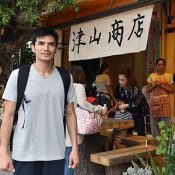
March 1, 2020 Ryukyu Shimpo
A Japanese-Filipino joint production film, The Amputee Boxer (title TBD), is currently being filmed in Okinawa. The movie is a human drama based on the true-life story of Naozumi Tsuchiyama, 37. Tsuchiyama, who hails from Nagasaki Prefecture, Japan, built his boxing career in the Philippines as an amputee and has moved to Okinawa since his retirement. The film is directed by internationally acclaimed Filipino filmmaker Brillante Mendoza, who has received numerous awards in international film festivals, including the Cannes Film Festival. The main character is played by Japanese actor Shogen, best known for his role in Okinawan Blue (Kokoro Odoru) directed by Tsukasa Kishimoto. The film’s Japan release date is yet to be determined.
Filming commenced at the end of January in the Philippines and moved to Okinawa on February 25, mainly on Ojima Island (Tamagusuku, Nanjo City). The crew is scheduled to film in Okinawa until the beginning of March before moving on to Fukuoka Prefecture.
Tsuchiyama had an amputation below the ankle at age 5. He began boxing in high school and enrolled in the Hiranaka Boxing School in 2001. Because boxers with prosthetic limbs are prohibited from joining the professional league in Japan, Tsuchiyama moved to the Philippines to become a pro boxer. He never made champion and retired in 2015.
While some details of Tsuchiyama’s life have been changed for the big screen (his character is an Okinawa-native in the film, for example) the movie portrays Tsuchiyama’s attitude towards life and how he took on challenges in pursuit of his dreams, and explores human emotions of love, friendship, and pride.
Shogen, who is friends with Tsuchiyama, was the one who pitched the film to the Japanese film production studio Gentle Underground Monkeys. During an on-set interview on February 25, Shogen said, “I was drawn to Tsuchiyama because of his determination towards his dreams.” He added, “I hope to connect Okinawa and Asia with this movie.” Actress Kaho Minami plays the mother, and model Maaaya will make her film debut as the sister.
(English translation by T&CT and Monica Shingaki)
Go to Japanese
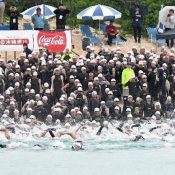
March 2, 2020 Ryukyu Shimpo
Miyakojima – The “36th All Japan Triathlon Miyakojima” (Hosted by Miyakojima City and the Ryukyu Shimpo Co. Ltd.) scheduled for April 19 was cancelled by the event’s executive committee at a special meeting held at the JTA Dome Miyakojima March 2, due to concerns over the effect the coronavirus could have on the event. Miyakojima mayor Toshihito Shimoji, who leads the executive committee, commented, “It is truly unfortunate. We never thought the event would come to an end at this moment, but our primary concern is the health and safety of the athletes and our citizens.”
According to the executive committee, this is the first time the triathlon has been cancelled. The management office will return the entrance fees to all of the participants, and announced that they would grant a special exception to the 65-year age limit for participants who planned on participating this year but will cross that limit next year. Approximately 22 million yen has already been spent on preparations for the event, and hereafter the Miyakojima city council will meet to discuss plans for making up for the lost revenue.
At a special committee comprising medical personnel and healthcare officials on February 27, where they voiced concerns such as “The source of the infection is difficult to specify,” and “Even if the virus is confirmed, there is only one medical facility on the island capable of accepting patients, which is insufficient,” and reaffirmed that the priority should be the health and safety of the athletes and local volunteers. For any questions about the triathlon, please contact the Miyakojima Triathlon executive committee at (Tel.) 0980 (73) 1046.
(English translation by T&CT and Sam Grieb)
Go to Japanese











 Webcam(Kokusai Street)
Webcam(Kokusai Street)


